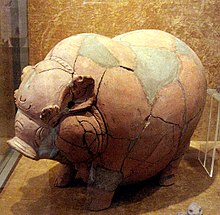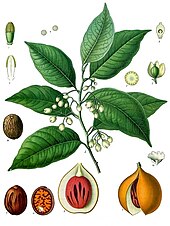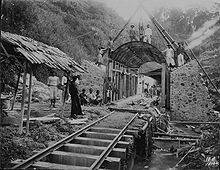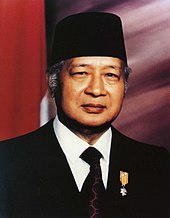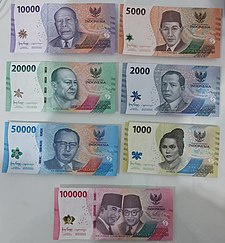
The history of Indonesia has been shaped by its geographic position, natural resources, a series of human migrations and contacts, wars and conquests, as well as by trade, economics and politics. Indonesia is an archipelagic country of 17,000 to 18,000 islands stretching along the equator in Southeast Asia. The country's strategic sea-lane position fostered inter-island and international trade; trade has since fundamentally shaped Indonesian history. The area of Indonesia is populated by peoples of various migrations, creating a diversity of cultures, ethnicities, and languages. The archipelago's landforms and climate significantly influenced agriculture and trade, and the formation of states. The boundaries of the state of Indonesia match the 20th-century borders of the Dutch East Indies.
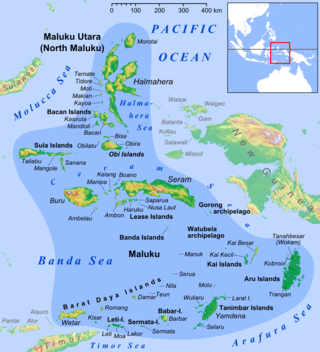
The Maluku Islands or the Moluccas are an archipelago in the eastern part of Indonesia. Tectonically they are located on the Halmahera Plate within the Molucca Sea Collision Zone. Geographically they are located east of Sulawesi, west of New Guinea, and north and east of Timor. Lying within Wallacea, the Moluccas have been considered a geographical and cultural intersection of Asia and Oceania.

Majapahit, also known as Wilwatikta, was a Javanese Hindu-Buddhist thalassocratic empire in Southeast Asia that was based on the island of Java. It existed from 1293 to circa 1527 and reached its peak of glory during the era of Hayam Wuruk, whose reign from 1350 to 1389 was marked by conquests that extended throughout Southeast Asia. His achievement is also credited to his prime minister, Gajah Mada. According to the Nagarakretagama written in 1365, Majapahit was an empire of 98 tributaries, stretching from Sumatra to New Guinea; consisting of present-day Indonesia, Singapore, Malaysia, Brunei, southern Thailand, Timor Leste, southwestern Philippines although the scope of Majapahit sphere of influence is still the subject of debate among historians. The nature of Majapahit's relations and influence upon its overseas vassals and also its status as an empire still provokes discussion.

Srivijaya, also spelled Sri Vijaya, was a Buddhist thalassocratic empire based on the island of Sumatra that influenced much of Southeast Asia. Srivijaya was an important centre for the expansion of Buddhism from the 7th to the 11th century AD. Srivijaya was the first polity to dominate much of western Maritime Southeast Asia. Due to its location, Srivijaya developed complex technology utilizing maritime resources. In addition, its economy became progressively reliant on the booming trade in the region, thus transforming it into a prestige goods-based economy.

South Sumatra is a province of Indonesia, located in the southeast of the island of Sumatra. The capital and largest city of the province is the city of Palembang. The province borders the provinces of Jambi to the north, Bengkulu to the west and Lampung to the south, as well a maritime border with the Bangka Belitung Islands to the east. It is the largest province in the island of Sumatra, and it is slightly smaller than Portugal. The Bangka Strait in the east separates South Sumatra and the island of Bangka, which is part of the Bangka Belitung Islands province. The province has an area of 91,592.43 km2 (35,364 sq mi) and had a population of 8,467,432 at the 2020 Census; the official estimate as at mid-2022 was 8,657,008. The province is rich in natural resources, such as petroleum, natural gas and coal. The province is inhabited by many different ethnic groups, with Palembangese being largest ethnic group. Most speak the Palembang language, which is mutually intelligible to both Indonesian and local Palembang Malay. Other ethnic groups include the Javanese, Sundanese, Minangkabau and Chinese. Most are concentrated in urban areas and are largely immigrants from other parts of Indonesia.
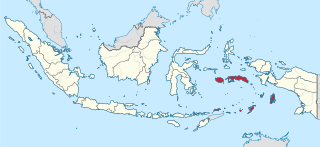
Maluku is a province of Indonesia. It comprises the central and southern regions of the Maluku Islands. The largest city and capital of Maluku province is Ambon on the small Ambon Island. It is directly adjacent to North Maluku, Southwest Papua, and West Papua in the north, Central Sulawesi, and Southeast Sulawesi in the west, Banda Sea, Australia, East Timor and East Nusa Tenggara in the south and Arafura Sea, Central Papua and South Papua in the east. The land area is 46,150.92 km2, and the total population of this province at the 2010 census was 1,533,506 people, rising to 1,848,923 at the 2020 census, the official estimate as at mid 2022 was 1,881,727. Maluku is located in Eastern Indonesia.

Kediri Kingdom was a Hindu-Buddhist Javanese kingdom based in East Java from 1042 until 1222. This kingdom is centered in the ancient city Dahanapura, despite the lack of archaeological remains, the age of Kediri saw much development in classical literature. Mpu Sedah's Kakawin Bharatayuddha, Mpu Panuluh's Gatotkacasraya, and Mpu Dharmaja's Smaradhana blossomed in this era. The kingdom's capital is believed to have been established in the western part of the Brantas River valley, somewhere near modern Kediri city and surrounding Kediri Regency.

The Netherlands Indies guilder was the unit of account of the Dutch East Indies from 1602 under the United East India Company, following Dutch practice first adopted in the 15th century. A variety of Dutch, Spanish and Asian coins were in official and common usage. After the collapse of the VOC at the end of the 18th century, control of the islands reverted to the Dutch government, which issued silver 'Netherlands Indies' guilder and fractional silver and copper coins until Indonesian independence in 1945.

The Catholic Church in Indonesia is part of the worldwide Catholic Church, under the spiritual leadership of the pope in Rome. Catholicism is one of the six approved religions in Indonesia, the others being Islam, Protestantism, Hinduism, Buddhism, and Confucianism. According to official figures, Catholics made up 3.12 percent of the population in 2018. The number of Catholics is, therefore, more than 8.3 million. Indonesia is primarily Muslim, but Catholicism is the dominant faith in certain areas of the country.

The National Museum of Indonesia is an archeological, historical, ethnological, and geographical museum located in Jalan Medan Merdeka Barat, Central Jakarta, right on the west side of Merdeka Square. Popularly known as the Elephant Museum after the elephant statue in its forecourt, its broad collections cover all of Indonesia's territory and almost all of its history. The museum has endeavoured to preserve Indonesia's heritage for two centuries.

The history of the arrival of Islam in Indonesia is somewhat unclear. One theory states that Islam arrived directly from Arabia as early as the 9th century, during the time of the Umayyad and Abbasid caliphates. Another theory credits Sufi travelers for bringing Islam in the 12th or 13th century, either from Gujarat in India or from Persia. Before the archipelago's conversion to Islam, the predominant religions in Indonesia were Hinduism and Buddhism.

Timor is an island in South East Asia. Geologically considered a continental crustal fragment, it lies alongside the Sunda shelf, and is the largest in a cluster of islands between Java and New Guinea. European colonialism has shaped Timorese history since 1515, a period when it was divided between the Dutch in the west of the island and the Portuguese in the east.

Agriculture in Indonesia is one of the key sectors within the Indonesian economy. In the last 50 years, the sector's share in national gross domestic product has decreased considerably, due to the rise of industrialisation and service sector. Nevertheless, for the majority of Indonesian households, farming and plantation remains as a vital income generator. In 2013, the agricultural sector contributed 14.43% to national GDP, a slight decline from 2003's contribution which was 15.19%. In 2012, the agricultural sector provides jobs to approximately 49 million Indonesians, representing 41% of the country's total labor force.

Company rule in the Dutch East Indies began when the Dutch East India Company appointed the first governor-general of the Dutch East Indies in 1610, and ended in 1800 when the bankrupt company was dissolved and its possessions were nationalized as the Dutch East Indies. By then it exerted territorial control over much of the archipelago, most notably on Java.

The Dutch East Indies, also known as the Netherlands East Indies, was a Dutch colony with territory mostly comprising the modern state of Indonesia, which declared independence on 17 August 1945. Following the Indonesian War of Independence, Indonesia and the Netherlands made peace in 1949. In the Anglo-Dutch Treaty of 1824, the Dutch ceded the governorate of Dutch Malacca to Britain, leading to its eventual incorporation into Malacca (state) of modern Malaysia.

The colonial architecture of Indonesia refers to the buildings that were created across Indonesia during the Dutch colonial period, during that time, this region was known as the Dutch East Indies. These types of colonial era structures are more prevalent in Java and Sumatra, as those islands were considered more economically significant during the Dutch imperial period. As a result of this, there is a large number of well preserved colonial era buildings that are still densely concentrated within Indonesian cities in Java and Sumatra to this day.

The currency of Indonesia, the rupiah, has a long history dating back to its colonial period. Due to periods of economic uncertainty and high inflation, the currency has been re-valued several times.

The military history of Indonesia includes the military history of the modern nation of Republic of Indonesia, as well as the military history of the states which preceded and formed it. It encompassed a kaleidoscope of conflicts spanning over a millennia. The ancient and medieval part of it began as tribal warfare began among indigenous populations, and escalated as kingdoms emerged. The modern part is defined by foreign colonial occupations, battles for independence through guerrilla warfare during Indonesian National Revolution, regional conquests and disputes with neighbouring countries, as well as battles between the Republic and separatist factions. Since the formation of the Republic, the military has played significant role in state affairs. However, in Post-Suharto era, the Indonesian military has retreated from politics, yet it still possesses some influences.

The Kingdomship of Bali was a series of Hindu-Buddhist kingdoms that once ruled some parts of the volcanic island of Bali, in Lesser Sunda Islands, Indonesia. With a history of native Balinese kingship spanning from the early 10th to early 20th centuries, Balinese kingdoms demonstrated sophisticated Balinese court culture where native elements of spirit and ancestral reverence combined with Hindu influences – adopted from India through ancient Java intermediary – flourished, enriched and shaped Balinese culture.
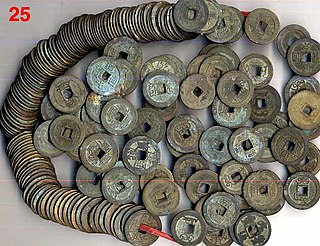
The cash coins of Indonesia was a historical currency in Indonesia based on Chinese imperial coinage during the Tang dynasty era. It was introduced by the Chinese traders, but did not become popular in Indonesia until Singhasari defeated the Mongol empire in 13th century. Chinese cash coins continued to circulate in Indonesian archipelago for centuries; when the Ming dynasty banned trade with the region, many local rulers started creating their own imitations of Chinese cash coins which were often thinner and of inferior quality. Cash coins produced in Indonesia were made from various materials such as copper-alloys, lead, and most commonly tin.

